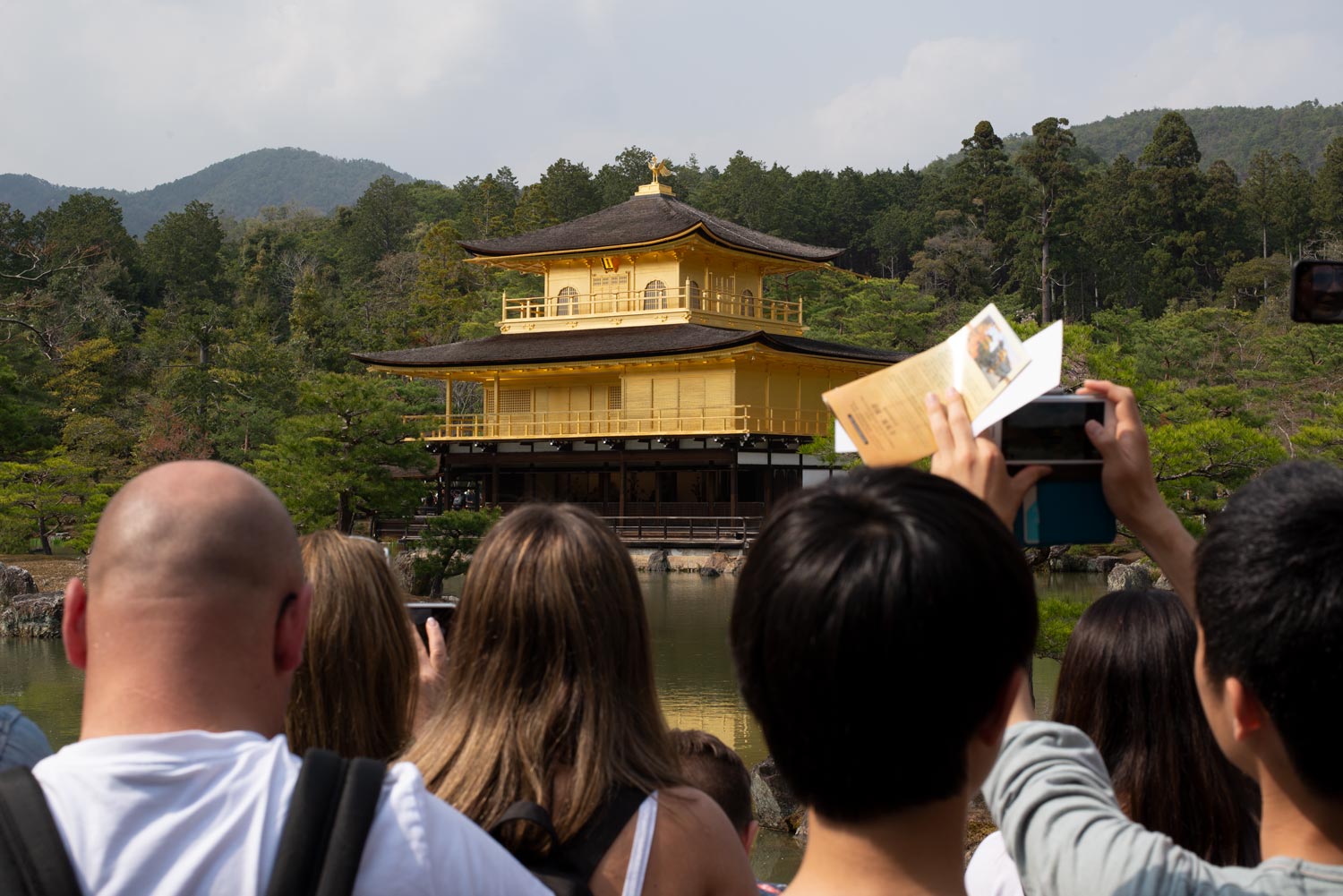Sustainable Tourism for Holidays
Photos by Forrest Anderson
The holiday season is upon us, and for record numbers of people that means travel.
As some of the world’s most famous tourist sites in the world become “overtouristed” with crowds of holiday-goers, it behooves us to add to our luggage a primer on how to be responsible, sustainable tourists. This blog is doing the Scrooge thing and getting this discussion over early in the season in hopes that more of us can go on to enjoy our holidays.
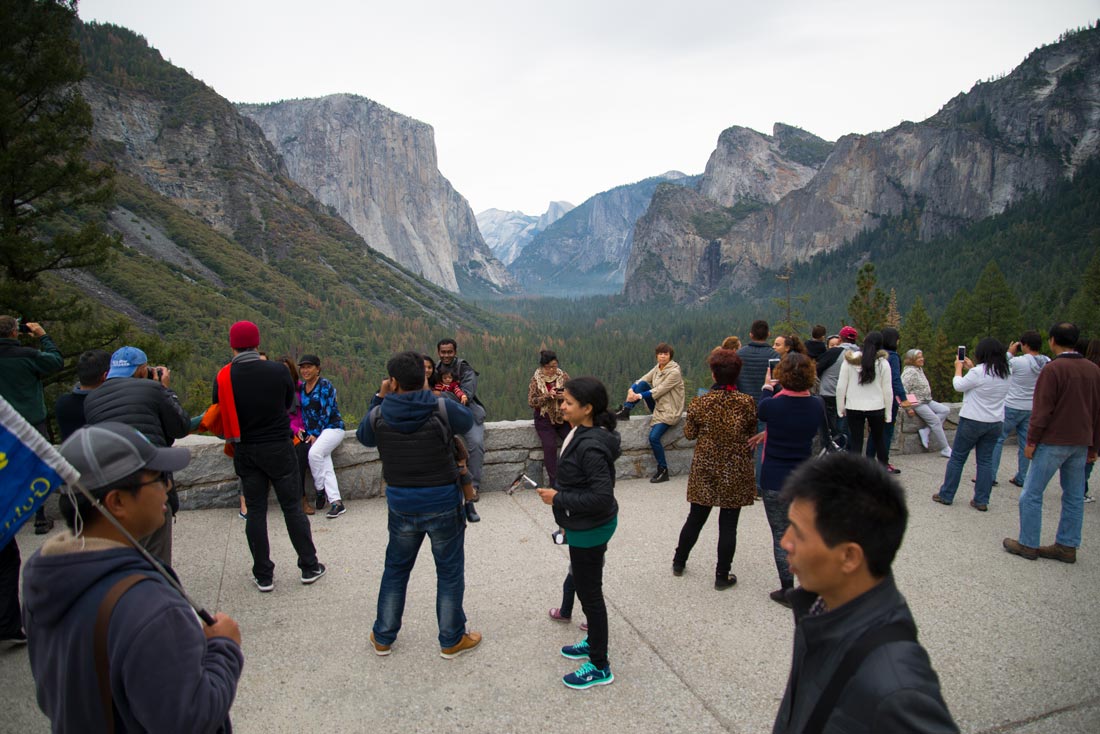
The days are long gone when Ansel Adams could take his famous photos in Yosemite, California, in splendid solitude. Here's what visiting Yosemite and most other popular tourist sites looks like now.
The city of Venice, Italy, is the poster child for places that are so overtouristed that their continued existence is being threatened, but there are many more. The European Union has identified 105 destinations that are in a state of overtourism. Many are our best-loved global destination sites.
This is happening because the number of international trips has burgeoned from 25 million in the 1950s to more than 1.3 billion. International arrivals are expected to be up to three billion by 2050. People also are traveling more domestically. At the same time, the major destination sites continue to be the same size and some have even shrunk. Many have declining populations that are dwarfed by the influx of tourists.
The reasons for the growth in tourist numbers include that it has become easier to cross borders, airline fares have declined because of inexpensive regional carriers and subsidized airline fuel, the earth’s population has tripled, and the global middle class, many of which travel at least once a year, has burgeoned. The number of tourists are expected to be up to 4.2 billion by 2022.
Jets and cruise ships are transporting the equivalent of entire towns of people to locations that often have fairly small local populations. Cruise ship passengers arrive in groups of thousands to crowd medieval streets in small cities. The local residents, cultures and environments can become overwhelmed by tourist crowds as fragile locations are loved to death.
Don’t get me wrong – these locations depend on tourism, which is worth some $1.7 trillion globally. But in many locations, it also has brought overcrowding, mountains of trash, infrastructure strain, cheap tourist trap businesses and rises in local real estate prices as housing is bought up for short-term tourist rentals. These factors can make living there problematic for locals and provide a disappointing experience for tourists.
It’s not necessarily that many more tourists are behaving more badly than they used to. It is just that a larger group and spectrum of people are traveling. Many are inexperienced travelers who aren't educated in how to function in a foreign culture. Social media also has amplified particularly egregious examples of tourist behavior that have damaged historical sites or offended local sensibilities.
Some of the world’s most valuable cultural, natural and historic locations are experiencing and responding to these challenges. Some cities are restricting the number of cruise ships that can dock at them, hotel development and short-term apartment rentals. Others such as Zion National Park have placed limits on the number of hikers allowed into fragile nature sites. Entire islands in the Philippines and Thailand have been closed to allow them to recover from tourism damage.
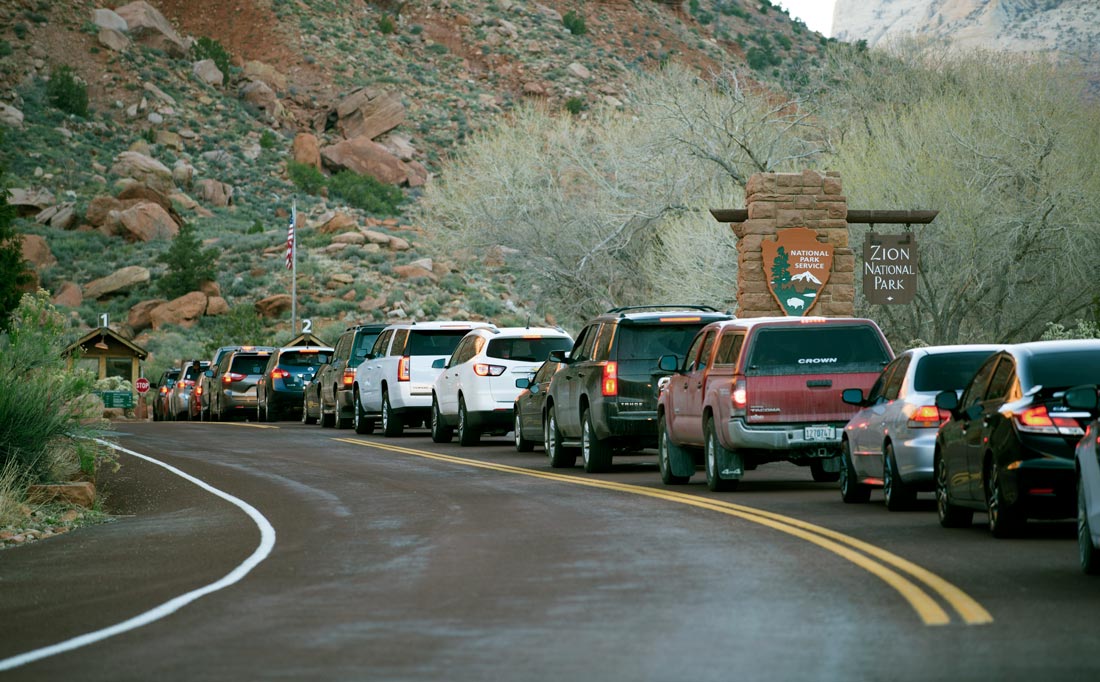
A line of cars entering Zion National Park. The most famous areas of the park are accessible only by shuttle bus - stop at a venue, get out, walk around and take pictures and get back on the bus. The park has limited access to some of the most spectacular hiking trails to curtail damage to the fragile environment.
Some countries which amassed stunning historical treasures and sites when they had the resources of an empire now are staggering under the weight of maintaining their cultural heritage when they are no longer imperial centers. Italy is one example.
Venice, Italy, is one of the hardest hit destinations, partly because of extreme overtourism and partly because it is experiencing serious flooding from sea levels rising while ground levels sink, a process accelerated by climate change. Many blame the problem on investment in tourism rather than protective infrastructure. Venice’s acute problems have prompted much study and it has the potential to become an international laboratory for tackling and resolving the environmental costs of tourism. Venice has only 55,000 local residents, but gets 32,000 cruise ship passengers between April and October, with the largest numbers in July and August. Cruise ships have collided with other vessels, causing significant damage ot the city’s waterways and lagoons. Cruise ships weighing over 100,000 tons have been banned from entering Venice’s Grand Canal. Cheap Airbnb rentals have driven up the cost of living for locals, some of whom have left. Turnstiles have been created to restrict the movement of visitors in more crowded areas. English-speaking police assistants patrol the busiest areas, warning tourists not to stick their feet in the canals or eat or drink in undesignated areas at risk of being fined. The city is requiring day-trippers to pay an entrance fee into the city because they add to the congestion and impact on the environment without contributing hotel taxes.
The ancient city of Pompei’s archeological ruins, which reached a crisis deterioration level a few years ago, have been restored. However, the site receives a record-breaking number of visitors, has a major shortage of guards and daily maintenance of the 163-acre site is hugely expensive. Some 3.6 million people visit it annually, a 70 percent increase in about a decade. Almost half a million people visit the site just in the month of July and about the same number in August. Visitors have stolen objects from the site, touched frescoes, set up tripods on fragile walls and used flash photography which damages ancient paint. Unauthorized tour guides operate in the park even though they are banned.
Rome has initiated guidelines for tourists to try to curb destructive or disruptive behavior. The city has banned street drinking; organizing pub crawls; playing in, climbing on or throwing items into a number of the city’s fountains; sitting on staircases of historic monuments; and eating snacks in some public places. Offenders can be sanctioned financially and then prohibited from accessing certain areas of the city for 48 hours. The city also has banned people from promoting tourist tours, selling tickets for museums, theaters and events and posing for money for photographs in historic costumes at some popular tourist sites.
France is managing its tourism impressively, but it is close to becoming oversaturated. It is the most visited country in the world, and many of its castles, churches and other historical sites are in need of repair. Before Notre Dame Cathedral in Paris spectacularly burned this year, sparking a worldwide fund-raising effort to restore it, it was in such need of repair that exterior carvings were falling off and being stored in sheds on the site. Many French towns with historically important structures have aging populations and their young people are looking for work elsewhere and outside of the tourism sector. It often is impossible for these communities to keep priceless historical sites in good condition.
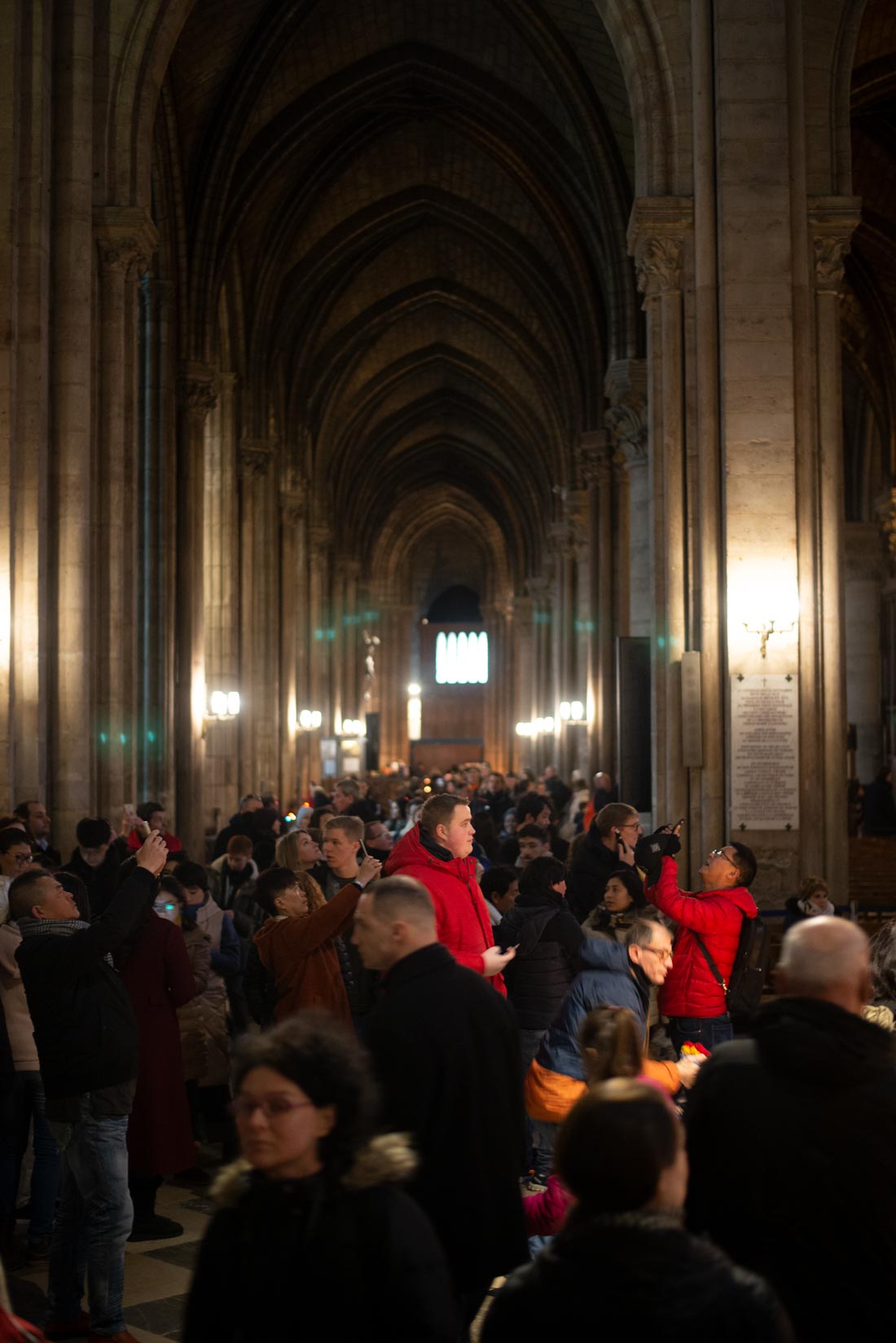
Crowds at Notre Dame in Paris before it burned. This was in the off season.
Some heavily visited European cities such as Amsterdam have changed their focus from promoting their destination to managing tourism. Few cities, however, have such tourism planning underway. Cities threatened with overtourism include Bangkok, Cape Town, Ho Chi Minh City, Istanbul, Jakarta, Mexico City and New Delhi.
In the United States, one of the worst examples of overtourism in my opinion is San Francisco. I grew up in Northern California, and San Francisco has always been one of my favorite places. However, the last time I went there, I decided not to go back. It was debilitatingly crowded in locations such as Fisherman’s Wharf, which had become a line of tourist trap stores stocked with junk, and the $6 parking fee for a half-hour trip to Ghirardelli Square for ice cream plus the huge crowds made me abandon a life-long ritual. I decided I’d rather buy Ghirardelli chocolate at a local store.
Lombard Street, the crookedest street in the world, often has traffic backed up while groups of tourists take selfies, seemingly oblivious that they are blocking other people including people who live in the neighborhood. Local residents complain that tourists often trespass in their yards or block them from getting to their homes. In response to the complaints, the city approved a toll-based reservation system for the street. Another area that has become clogged with tourists is the park lined with the famous colored Victorian houses called Painted Ladies. Tourism is a big draw for the city, which is working to clean up other sections of the city to syphon off some of the tourism to them.
The crowds have become so unmanageable in many places that they are threatening the local character of popular destination spots. Tourists with cellphones and cameras chase geishas down historic streets in Kyoto, Japan, as they go to work. The city of Kyoto has introduced a smartphone app that asks tourists not to chase the geishas or lie down in the streets to take photos. Many tourist cities have only signs in English in their most popular historic districts and the shops in them sell mainly brands you can buy at your local mall. Iceland gets six times the number of tourists as the number of native Icelanders. At many destination spots when you snap pictures of local scenes, the people in them are more likely to be fellow tourists than local people.
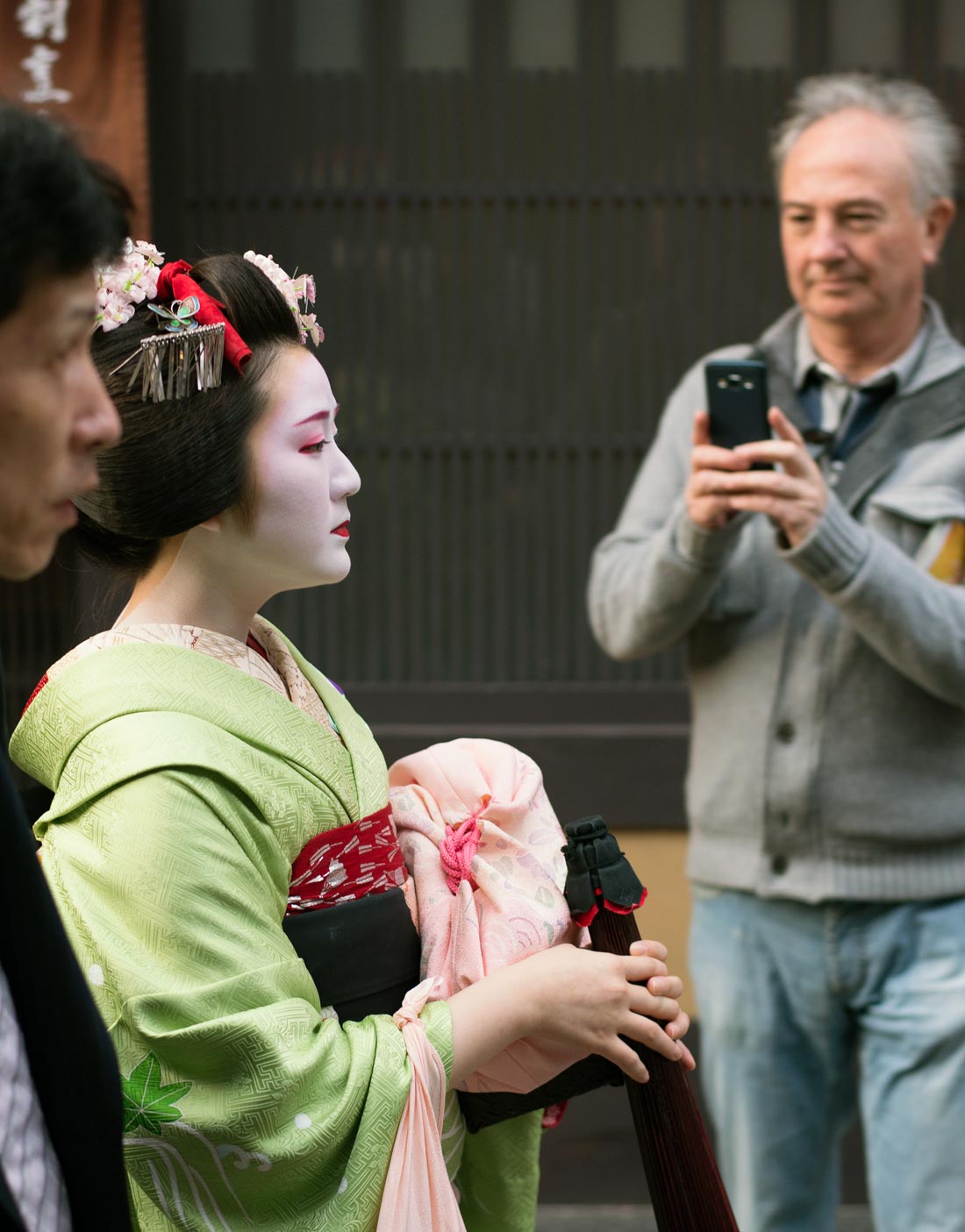
A geisha headed to work in a crowd in Kyoto, Japan.
Many people who don’t work in the tourism industry but live in tourist destinations have had their lives severely disrupted by tourism. There's the old saying that the main reason not to own a castle in Scotland is that everyone will want to come and visit you, but the problems of overtourism go far beyond that. Rising real estate prices, the building of high rise hotels that has ruined favorite beaches and nature areas, crowds and tourist traffic that make it impossible for local residents to go downtown in their home cities are other problems. Some places are limiting the number of buses and insisting that bus visitors prebook. Some are charging buses a drop-off fee per passenger and a similar amount for cruise visitors to disembark. Some cities are banning groups of more than a few people in their city centers and entirely in some locations. Others ban different kinds of guided tours or charge travelers on any group tour a tax. Some temples in Japan refuse to allow foreign tour groups to enter or close their doors when cruise ships are in port. Some areas have placed restrictions on appropriate attire to be worn in some historic areas.
The majority of international tourists are from the United States and China. Not surprisingly, then, that these tourists generally are high on the list in polls of badly behaved tourists. They are far from the only ones, though. The British, Brazilians, Germans, Italians, French, Indians, Australians and Russians are among tourists who rank high in these polls.
Americans sometimes get poor reviews for being loud, rude, fat, demanding and wearing terrible fashion. Drunkenness, spitting, littering, offensively immodest clothing and demeanor, stealing and arrogance are among other practices that can earn tourists from any country a bad behavior label.
After a Chinese teenager carved his name in Chinese characters on the 3,500-year-old stone at the Luxor Temple in Egypt and complaints surfaced from a number of countries about the conduct of Chinese tourists, China’s government responded to an outpouring from the embarrassed and outraged Chinese Internet community by publishing a citizens’ guide to being a good tourist. The reaction to the influx of Chinese tourists to many countries has been mixed, however. As areas have gotten used to the large influx of Chinese tourists and Chinese have become more experienced travelers, many areas have found them polite and willing to pay well. Many blend in with their local environment, having studied abroad and learned foreign languages.Those tourists are being welcomed by the international tourist industry.
The general increase in tourism has allowed the tourism industry in some countries to become choosier about the type of tourists they welcome. Many hotels prefer to book couples to bachelor or bachelorette parties, for example.
What can we do to be responsible, sustainable tourists? Having had careers in international journalism that have included a great deal of travel, we have learned a few things that can help other travelers as well.
- Be conscious of the impact you make when you travel. Move about unobtrusively, spend money wisely, speak to people courteously and avoid disrupting local people’s lives.
- Avoid traveling to and visiting heavily visited places at peak times. You’ll have a better experience and so will the local residents. We travel to Europe after the Christmas season and are rewarded with less expensive fares and accommodations and less crowded venues. We also avoid the peak times when visiting museums and sights. We try to go early or late or on days when there is lighter attendance. A good trick if you want to have a more solitary time, either to take photographs or just avoid the crowds at a museum or historical site, is to go through it in the opposite direction from the path the museum brochures outline. We lived for a number of years just down the street from the Forbidden City in Beijing, China. This is one of the most popular historical sites in the world, with huge crowds going through it daily. However, by starting in the morning at the end of the most popular route through it, we often had sections of it to ourselves. We also visited during rain or snow storms, when fewer people were there. Rainy days make beautiful, saturated photos of buildings, often with the buildings or lights from them reflecting in wet pavement. Another trick is to photograph buildings at around dinnertime, when fewer people are there and the “golden hour” of twilight makes them glow. If you find large crowds around something you want to see or photograph at a popular venue, circle back around later and the crowds may have thinned out.
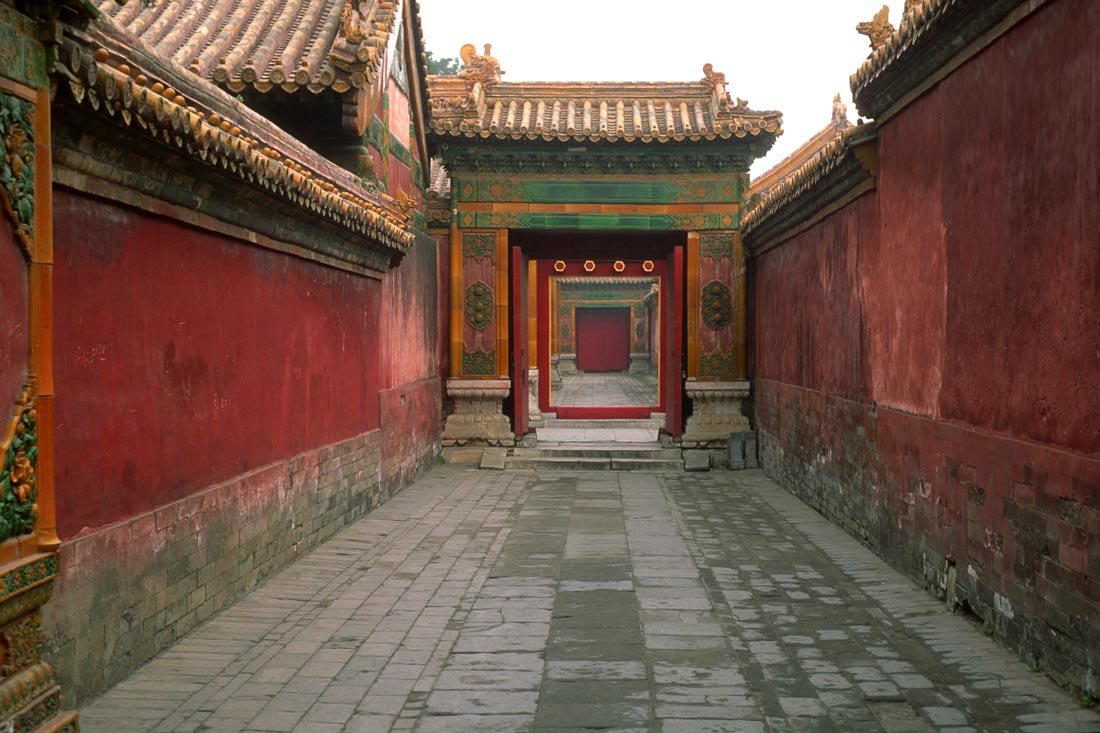
We took this photo in a deserted corridor in the Forbidden City by going the opposite direction of the crowds, entering at the exit in the morning. No people were there because the crowds gather in the morning at the opposite end of the Forbidden City and most of them don't get to this spot until late in the day.

This photo at Bryce Canyon National Park was taken during a hike in the snow. Almost no one was on the trail besides us. During the summer, this trail has a constant line of hikers.

The Rosetta Stone surrounded by crowds at the British Museum in London. We moved past it and returned later in the day, when no one was there and we were able to photograph and study it in detail.
- Try to avoid staying at places that are renting multiple units for short-term rentals, as these boost local property values beyond what is affordable for locals.
- Travel in less well-known places. This is a good strategy even if you hit the most popular sites. Let me explain. There are going to be huge crowds around the Mona Lisa at the Louvre whenever you visit it. Observe it briefly and then spend most of your time viewing the beautiful paintings by other famous Renaissance masters or seeing other Leonardo Da Vinci works there. Unlike the heavily guarded Mona Lisa, you can walk right up to them and examine the paint strokes.
- Try not to be the kind of tourist that pours off cruise ships in hordes to choke city centers, holds rowdy loud parties, and blocks or pushes aside others to take selfies or, worse, hours of destination wedding photos. Think carefully about the environmental impact of cruises before you book one. Cruise ships have become a major problem for some ports in Europe. In Venice, local residents stage regular protests against cruise ships dwarfing their waterfront. Some cruise lines have angered people by dumping trash into the ocean. Cruise ships that dock at locations for just a day provide little benefit to local economies. Amsterdam charges cruise passengers almost $8 per day for arriving there.
- At least learn how to greet people, say thank you and order food in the language of the country you are visiting.
- Pipe down. Avoid boisterous behavior in public. Many crowded countries such as Japan are far more pleasant to travel in than some less crowded areas because most people speak quietly and are courteous in public.
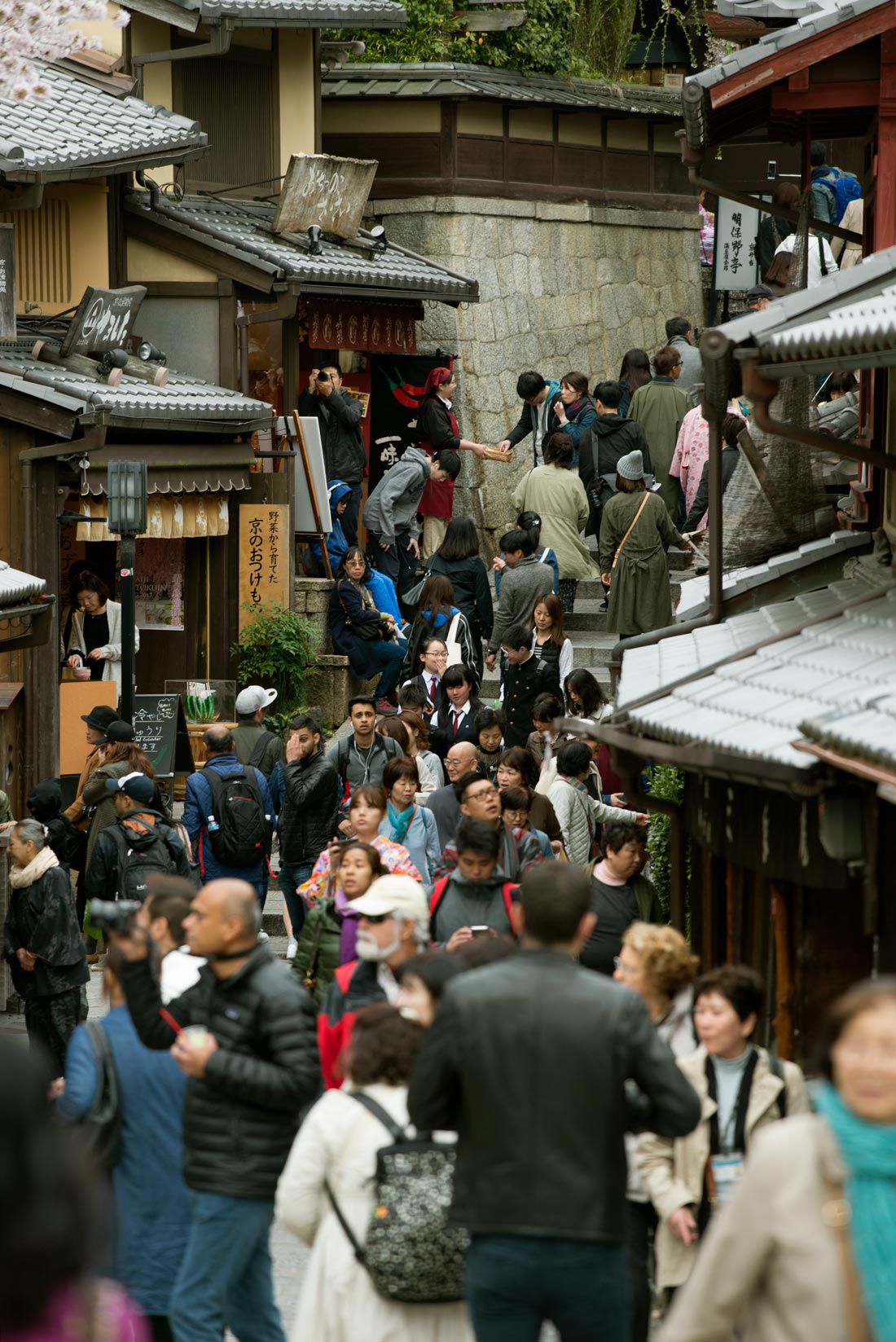
Crowds in a popular tourist area in Kyoto, Japan. Crowds in that country tend to be quiet, polite and careful about keeping restrooms and other public facilities clean, which goes a long way toward making a pleasant experience for travelers.
- Never run out of money and then ask locals to help you pay your way. Yes, believe it or not, this is a thing. It’s a serious problem in some places like Hong Kong and Bali.
- Recognize that when you stop people to ask them directions, they may have had to deal with five of you that day. Be courteous and brief. Better yet, plan ahead and map out where you are going so you don’t have to bother them.
- Be courteous and brief at crowded restaurants and other venues, recognizing that you’re the one who chose to show up and join the crowds. Many tourist places are overwhelmed and understaffed, but are trying their best to serve you and others. If you want the same treatment and attention you would get at home, don’t travel to the most popular and crowded destinations. Workers simply may not have time amidst the crowds to accommodate you with the same level of service you may be accustomed to in your home town, especially if you don’t speak the native language.
- Watch your children and take the opportunity to teach them how to behave as guests in foreign countries. I was horrified as I watched an American tourist laugh and loudly egg on his child who was swinging on the beautifully crafted rope of a sacred bell at a temple in Japan. This would have been a great opportunity for the father to teach the child about respecting property and other people’s cultures and religions. Instead, the father chose to teach his child the opposite. I admired the forebearance of the people who ran the temple in not throwing the two of them out.
- Cut it with the selfies alright already. It’s beyond me why hordes of people pay a lot of money to push their way to the front at world-class locations to take a picture of … themselves, with the location appearing hazily in the background, and then walk off without looking at what they came to see. This is a boorish phenomenon that clogs famous sites all over the world. Not long ago, I was roughly shoved out of the way (I happened to be on crutches at the time, incidently) by a horde of tourists outside Buckingham Palace who then turned around with their backs to the parade of mounted guards and photographed themselves. Most well-known tourist sites already ban tripods, and I can foresee photography bans spreading if the selfie fanatics don’t get a grip. This will be a sad day for tourists who want to take thoughtful, informative photos of those sites.
- Get over the idea that you're going to arrive at a popular destination and it will all be like the idyllic pictures in a tourist brochure. Those pictures are carefully extracted from the chaos of ordinary life in any location. Sometimes if you can't get the perfect photo, give up and take what's there. It may be much more interesting and certainly will be more accurate.
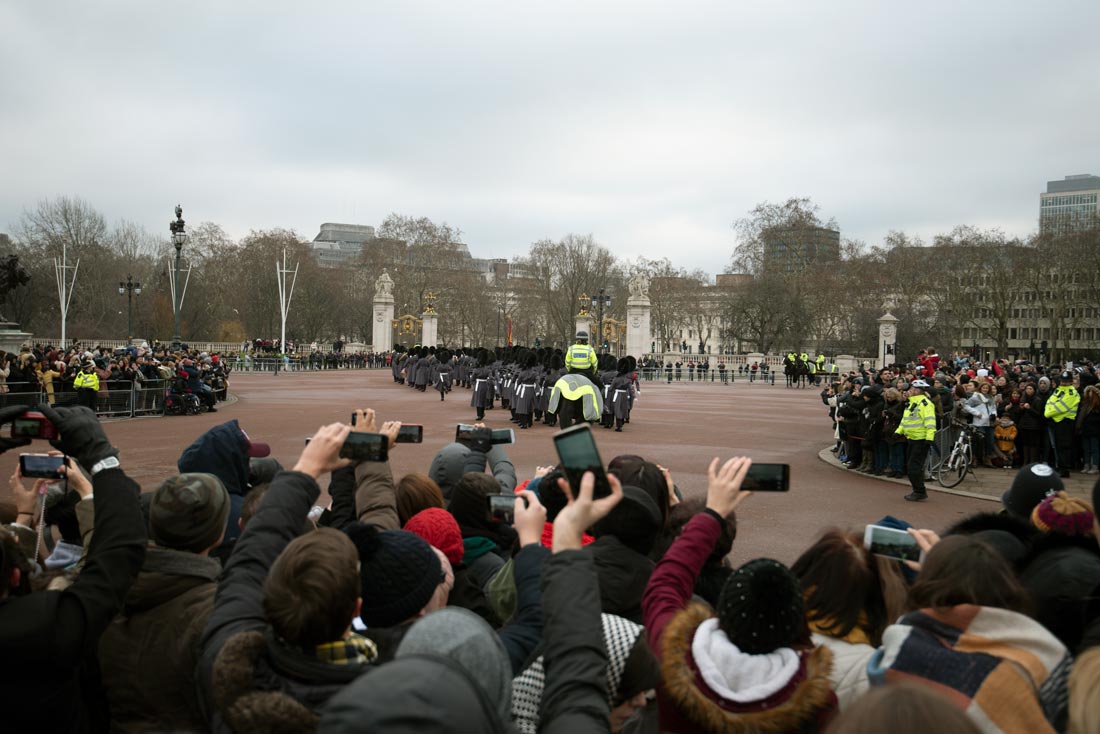
Tourism ads have created unrealistic expectations about some locations. Here is the reality of the daily changing of the guards at Buckingham Palace in London. Recognizing that the mounted guards were ceremonial and the real security was represented by the police car behind them, we decided to photograph the scene as it really is.

- Go to fewer places and stay for more than a day. Those who visit locations for just a day are less welcome because they don’t pay the tourist taxes that help clean and maintain cities although they leave behind trash and use the infrastructure. Day trippers also are less likely to spend time and money at small local businesses. Some locations are introducing entrance taxes for day trippers.
- Minimize plastic consumption with such practices as using reusable bags. Ask the hotel not to change your sheets and towels daily and stay in hotels with recycling programs. Become a conservation ambassador.
- Consider staying outside the city center if doing so won’t put added pressure on the city’s infrastructure. Regardless of where you stay, be conscious of the strain you put on a location's infrastructure. Go out of your way to be courteous on public transport and travel at non-peak times when you can.
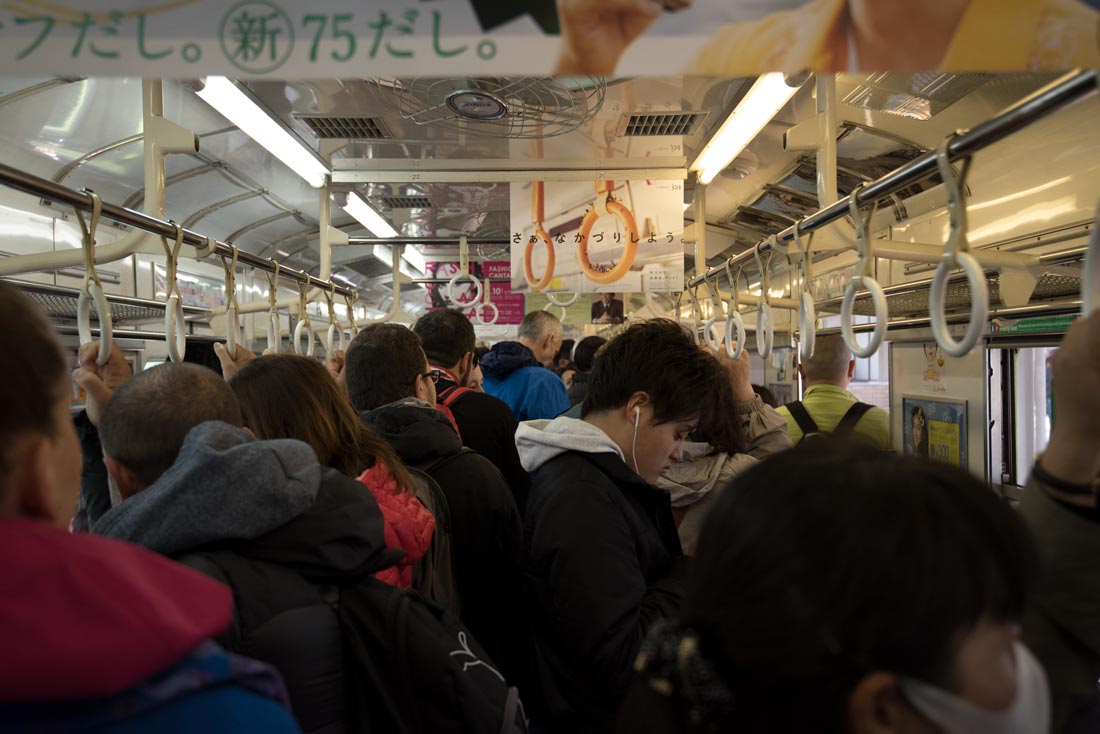
Tourism places a strain on public transportation in many areas. We can lighten our footprint by traveling on it at less peak times and by being courteous and quiet when we have to travel at peak times.
- Aircraft account for 2 percent of greenhouse gas emissions. Take direct flights as much as possible, as having several layovers increases your carbon footprint.
- Buy local organic products at grocery stores and famer’s markets at your destination.
- Buy from local business and eat in local restaurants so you circulate money in the local economy and create jobs for local people. Avoid buying products made with endangered materials such as rosewood.
- Never deface anything and don’t climb on or touch cultural relics if you can avoid it. Leave things as you find them and educate family and friends to do so by your example.
- Read up on local expectations for public conduct and dress and comply with them. In general, dress discreetly and modestly to avoid offending people.
- Don’t block street or pedestrian traffic for any reason. Try to stay out of the way of people going about daily activities.
- If you're staying with relatives or friends who live in a popular destination spot, be conscious of the fact that they may have had longer periods of having house guests this year than periods without them and that entertaining house guests is time-consuming and can be expensive. Having a home in a popular destination spot can make people popular, but it comes with a price. Be courteous of the time, work and financial outlay that your visit requires them to contribute and take care not to interfere with their schedule or invade their privacy any more than you have to.
- Don’t criticize local customs or religious beliefs. Show respect for them. Silence cell phones at holy sites and walk and speak quietly at them. Speak quietly at historical sites and museums. Be as discreet as possible.
- Slow down. Rather than covering the globe faster and covering greater distances, do less more slowly. Take the time to savor the experience. It’s about the quality of the experience, not the quantity.
- Do something meaningful on your travels – don’t just take selfies at all the most famous spots. Do family history, volunteer (wisely), learn a new skill, take the opportunity to learn about the culture and history.
- If you can afford it, chip in a bit at popular sites to help pay for restoration or upkeep.
- Related photos:
- Yosemite National Park
- Zion National Park
- Notre Dame de Paris
- Kyoto, Japan
- Forbidden City, Beijing, China
- Bryce Canyon National Park
- Buckingham Palace, London
Check out these related items
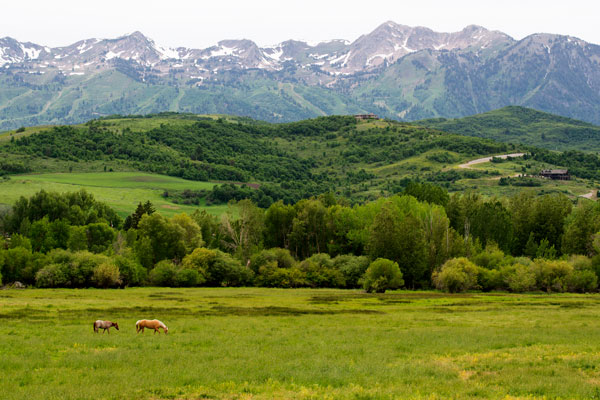
Home is Where the Vacation is
Vacationing at home looks to be the main travel trend for the near future. Here are some ways to enjoy it.

Travel is So Daily
As more and more travelers are discovering, travel is more about enhancing the life you have than escaping from it.

Sustainable Clothing
The trade war with China. Environment degradation. Household debt. To bring all of them into focus, we can look in our closets.
